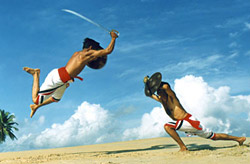Indian martial arts have a rich heritage and tradition, highly acclaimed in India and abroad and are quite varied in nature. Each region in India is unique in practicing martial arts in great vivacity and enthusiasm.
A number of ancient Dravidian martial arts were originated in South India. In Tamil Nadu `Kuttu Varisai `is a special art of fighting with empty hands. Another famous art form ,
Varma Kalai or the art of vital points is also widely practiced. It is primarily made out of deer horns. It is treated like a double bladed dagger.
Kerala is the hub of special forms of Indian martial arts like Kalarippayattu (way of the arena) and Adithada (attack and defend). Kalarippayattu is an important martial art form, mainly developed in the 11th century, during the rule of Chola dynasties. Kalarippayattu is an Indian martial art practiced in Kerala and Tamil Nadu. It integrates strikes, bangs, grapple, martial dance, and arms, as well as curative techniques What is also interesting is that Indian martial arts are improvised due to certain ancient theories like
Yoga,
Ayurveda and Tantra, Kundalini, Prana, Nadi, Chakra and Marmam.
The history of Indian martial arts is quite interesting. Early martial traditions go back to the 2nd millennium BC. It got due mentioning in Indian Vedic literature like the Rig Veda, Yajur Veda and Atharva Veda. It described how to improve a warrior`s individual artistry and kill enemies using various different methods in warfare, whether a warrior went to war in chariots, elephants, horses, or on foot. Among varied Indian martial arts,
Malla-yuddha was regarded as a prominent martial art in that era. It is a form of combat wrestling codified into four forms, which is described, in the ancient Indian epics as the fighting style of warriors such as Bhima. Innumerable references of Indian martial arts are found in almost every lines of Mahabharata. For example in the prolonged battle between Arjuna and Karna using bows, swords, trees and rocks, and fists, in unarmed battle where two fighters boxing with clenched fists and fighting with kicks, finger strikes, knee strikes and headbutts. Other boxing fights too are enumerated in Mahabharata and Ramayana. Apart from these the references of Indian martial arts too are found in various literary works. The martial art of Vajra Mushti was described in the Buddharata Sutra, written down by the 5th century. Indian military accounts of the Gupta Empire gave a vivid description of more than 130 different classes of weapons. Even in Vatsyayana`s Kama Sutra throw light on the fact that women would often "practice with sword, single-stick, quarter-staff, and bow and arrow." Indian works of art, particularly in temple sculptures show warriors in positions related to the martial arts.
In the British era, Indian martial arts got a face-lift. The British Raj eventually banned Kalarippayattu in 1804 in response to a series of revolts. However, 1920s is the era of rediscovering and preserving the traditional arts of South India and once again Kalarippayattu gained public attention.
Indian martial arts throws light on the Indian tradition of fight and self-defense and in the process revived as the superior art form
